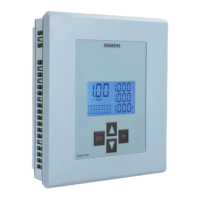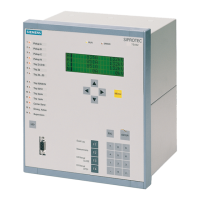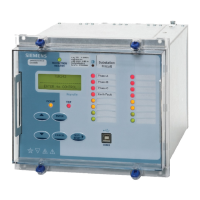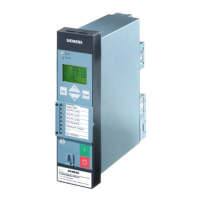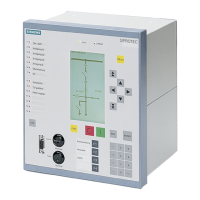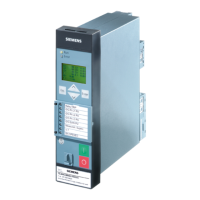7UT51 v3
Bus Differential Protection (87B)
6
PRIM-2330C 83
6.4 Trip Characteristic
As shown in Figure 6.1, Figure 6.2, and Figure 6.3,
CTs measure the currents flowing into and out of the
protected zone of the bus. The relay matches the
currents by taking into account the characteristics of
the bus, as well as the winding ratios of the CTs. Then
the differential protection function calculates
(separately for each phase) the “differential current,”
I
diff
:
(two branch bus) (6.1)
(three branch bus) (6.2)
The differential current,
I
diff
, is a scalar quantity that is
the absolute value of the amplitude of the vector sum
of the fundamental component of each matched
phase-current flowing into the protected zone of the
bus. In a system composed of ideal components, a
non-zero differential current is a certain indication of a
fault somewhere within the protected zone.
As described in Section 6.1 on page 79, the non-ideal
behavior of a real system may result in a differential
current when in fact no fault exists within the protected
transformer. In these cases, the differential protection
must be restrained. To do so, the relay calculates
(separately for each phase) a “restraining current,”
I
rest
:
(two branch bus) (6.3)
(three branch bus) (6.4)
The restraining current,
I
rest
, is the scalar sum of the
absolute value of the amplitude of the fundamental
component of each matched phase-current flowing
into the protected zone of the transformer. It is
proportional to the total amount of current flowing
through the bus.
Note:
To illustrate the use of the restraining current,
consider three operating situations for a
two-branch bus:
• During normal operation, or if there is a fault
outside of the protected zone, , so:
(6.5)
(6.6)
• If there is a short circuit within the protected zone
with equal currents entering from each side,
, so:
(6.7)
(6.8)
• If there is a short circuit within the protected zone
with current entering from only one side, ,
so:
(6.9)
(6.10)
Note:
For an internal short-circuit fault,
I
diff
= I
rest
.
The differential protection function uses the
instantaneous values of
I
diff
and
I
rest
to plot the
location of the “operating point” on the trip
characteristic shown in Figure 6.3. The shape of the
trip characteristic is configured using the settings
described in Section 6.4.1 on page 84.
I
diff
=
′
+
′
II
12
I
diff
=
′
+
′
+
′
II I
12 3
I
rest
=
′
+
′
II
12
I
rest
=
′
+
′
+
′
II I
12 3
′
=−
′
II
21
I
diff
=
′
+
′
=
′
−
′
=II II
12 11
0
I
rest
=
′
+
′
=
′
+−
′
=⋅
′
II I I I
12 1 1 1
2
′
=
′
II
21
I
diff
=
′
+
′
=
′
+
′
=⋅
′
II II I
12 11 1
2
I
rest
=
′
+
′
=
′
+
′
=⋅
′
II II I
12 11 1
2
′
=I
2
0
I
diff
=
′
+
′
=
′
+=
′
II I I
12 1 1
0
I
rest
=
′
+
′
=
′
+=
′
II I I
12 1 1
0

